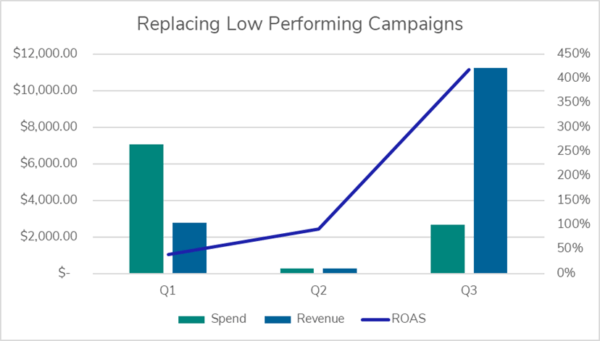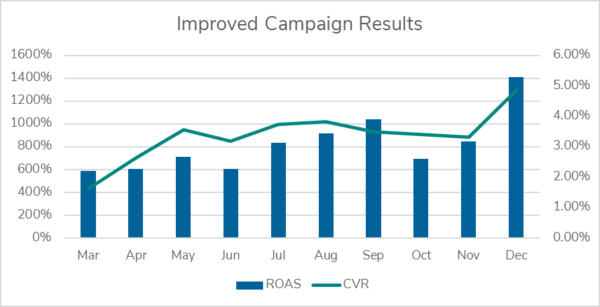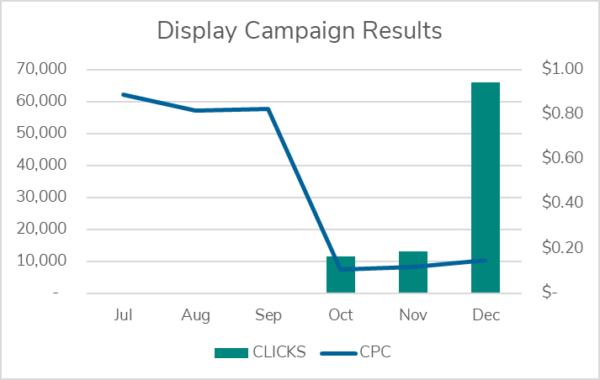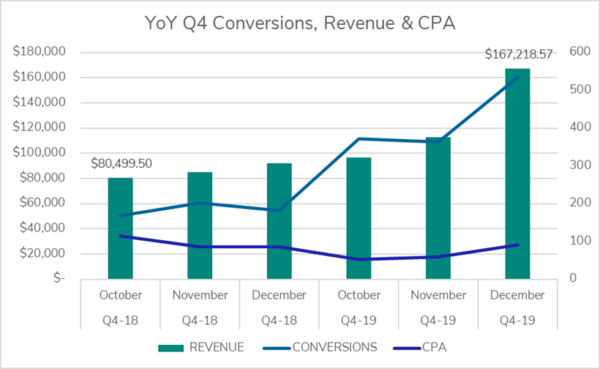Sometimes your business gets stuck. You try this, you try that…how do you get unstuck? At (un)Common Logic, we use a data-driven, meticulous approach to help clients grow by
- diving deep into the data for insights
- using what we learn to expand strategically, and
- taking into account the unique factors of the business when planning campaigns
Let’s look into the details of one long-term client in industrial services to see how we used our approach to help them break through a business plateau.
The Initial Situation
This large online industrial service provider faced a business challenge that had been developing for a while. After years of growth, they hit a plateau. More competition (in their case, from Amazon resellers) offering lower prices was eating into their market share. Overall paid media demand uptick had increased spend without a proportional growth in revenue. How could we refine the paid media efforts and drive new growth?
First, we did what we always do: look into the details of the account. When we did that, we found some campaigns were spending on generic keywords with a very low return on investment. Other campaigns were using outdated image ads and targeting small audiences.
Our findings led us to update tactics to reduce inefficient spending and improve the ways this client reaches their audience.
Replace low performing campaigns
The account initially had many campaigns with small budgets and low returns. These many small budgets added up, though, and made managing and optimizing very difficult. To allocate spend strategically and get more traffic, we paused low-return campaigns and decided to capture some of the lost volume by building dynamic search campaigns (DSA). DSA campaigns allow us to increase paid media reach as well as help us to manage spend efficiently by targeting all relevant pages and matching to queries that are not already in the account.
Months after we launched DSA campaigns we have seen revenue from them surge at a higher return than the campaigns they replaced.

Refine moderately performing campaigns
Other campaigns were structured properly but we knew they could perform better. We looked for ways to improve them from both the macro and micro directions, looking at high-level settings for these campaigns as well as granular modifiers.
In looking at the settings, we noticed that some of these campaigns were on manual bidding. To better capture quality clicks at a lower cost, we set up an experiment to test half of these campaigns’ traffic on enhanced CPC (eCPC), which helps get more conversions while maintaining control of bids. The test was successful: eCPC attracted more clicks to the site at a lower cost. After applying eCPC to these campaigns, we got more clicks at a stable CPC.
The next step to control costs was to block Amazon-related queries, since competing with Amazon resellers brought up both parties’ costs without growing overall revenue for our client. After we made sure we were staying clear of these types of queries, the account saw both a lower spend and a higher return.
We then conducted performance analyses on device types, time of day, location, and other adjustments to identify any over- or under-performing levers. By adding customized bid modifiers to those attributes for each campaign and ad group, we were able to improve these campaigns’ return and CVR.

Improve and expand display advertising
At the time, display campaigns were primarily appearing to past site visitors and were also using traditional image ads. To grow, the client’s display campaigns needed to actively reach out to mid-to-higher funnel traffic and build brand awareness, as well as nurture the remarketing list.
The first thing we did is to expand the audience. We looked deep into Google’s IMA (in-market audience) segments, identified a few highly relevant audiences, and added those to a new prospecting campaign. Utilizing the custom audience function in Google Analytics, we were also able to target visitors who had been to other social channels with search ads.
Within both the remarketing and prospecting campaigns, we updated the ad copy to responsive display ads (RSA). This ad type is more flexible, appearing in various placements without needing to upload multiple sizes. RSAs also have headlines and description lines in addition to images, giving searchers more information.
Next, we built new GSP (Gmail sponsored promotion) campaigns to run on Gmail ads as well. Gmail ads have the possibility of reaching the over 1 billion Gmail users around the world as well as mobile first experience. With all above tactics implemented, we have seen more site traffic at a lower cost for display ads.

Make Offers Count
Due to seasonality and the usual purchase cycle for their customers, this client typically sees lower sales around Q3 and early Q4. To combat this negative trend, we have developed a strategic offer schedule with the client that starts earlier and includes various stages, each containing an increasingly discounted offer. When launching the offer, we utilized countdown ad copy to highlight the urgency of the sale and ran it with regular offer expanded text ads to increase visibility. On DSA campaigns, we maximized the offers’ exposure by adding dedicated landing pages as URL targets. To encourage prospective buyers further, we built remarketing lists to target users who visited the offer pages but hadn’t yet purchased.
As a result of these refinements, improvements, and expansions, the client saw tremendous Q4 growth.

By thinking strategically about the particulars of this client’s business and implementing tactics which addressed what we saw in the data, we were able to break the plateau and this client has experienced significant growth through digital marketing.
Contact us to learn more about the (un)Common Logic approach to using data to refine and improve your digital marketing to achieve your business goals.
- diving deep into the data for insights
- using what we learn to expand strategically, and
- taking into account the unique factors of the business when planning campaigns
The Initial Situation
This large online industrial service provider faced a business challenge that had been developing for a while. After years of growth, they hit a plateau. More competition (in their case, from Amazon resellers) offering lower prices was eating into their market share. Overall paid media demand uptick had increased spend without a proportional growth in revenue. How could we refine the paid media efforts and drive new growth? First, we did what we always do: look into the details of the account. When we did that, we found some campaigns were spending on generic keywords with a very low return on investment. Other campaigns were using outdated image ads and targeting small audiences. Our findings led us to update tactics to reduce inefficient spending and improve the ways this client reaches their audience.Replace low performing campaigns
The account initially had many campaigns with small budgets and low returns. These many small budgets added up, though, and made managing and optimizing very difficult. To allocate spend strategically and get more traffic, we paused low-return campaigns and decided to capture some of the lost volume by building dynamic search campaigns (DSA). DSA campaigns allow us to increase paid media reach as well as help us to manage spend efficiently by targeting all relevant pages and matching to queries that are not already in the account. Months after we launched DSA campaigns we have seen revenue from them surge at a higher return than the campaigns they replaced.
Refine moderately performing campaigns
Other campaigns were structured properly but we knew they could perform better. We looked for ways to improve them from both the macro and micro directions, looking at high-level settings for these campaigns as well as granular modifiers. In looking at the settings, we noticed that some of these campaigns were on manual bidding. To better capture quality clicks at a lower cost, we set up an experiment to test half of these campaigns’ traffic on enhanced CPC (eCPC), which helps get more conversions while maintaining control of bids. The test was successful: eCPC attracted more clicks to the site at a lower cost. After applying eCPC to these campaigns, we got more clicks at a stable CPC. The next step to control costs was to block Amazon-related queries, since competing with Amazon resellers brought up both parties’ costs without growing overall revenue for our client. After we made sure we were staying clear of these types of queries, the account saw both a lower spend and a higher return. We then conducted performance analyses on device types, time of day, location, and other adjustments to identify any over- or under-performing levers. By adding customized bid modifiers to those attributes for each campaign and ad group, we were able to improve these campaigns’ return and CVR.
Improve and expand display advertising
At the time, display campaigns were primarily appearing to past site visitors and were also using traditional image ads. To grow, the client’s display campaigns needed to actively reach out to mid-to-higher funnel traffic and build brand awareness, as well as nurture the remarketing list. The first thing we did is to expand the audience. We looked deep into Google’s IMA (in-market audience) segments, identified a few highly relevant audiences, and added those to a new prospecting campaign. Utilizing the custom audience function in Google Analytics, we were also able to target visitors who had been to other social channels with search ads. Within both the remarketing and prospecting campaigns, we updated the ad copy to responsive display ads (RSA). This ad type is more flexible, appearing in various placements without needing to upload multiple sizes. RSAs also have headlines and description lines in addition to images, giving searchers more information. Next, we built new GSP (Gmail sponsored promotion) campaigns to run on Gmail ads as well. Gmail ads have the possibility of reaching the over 1 billion Gmail users around the world as well as mobile first experience. With all above tactics implemented, we have seen more site traffic at a lower cost for display ads.
Make Offers Count
Due to seasonality and the usual purchase cycle for their customers, this client typically sees lower sales around Q3 and early Q4. To combat this negative trend, we have developed a strategic offer schedule with the client that starts earlier and includes various stages, each containing an increasingly discounted offer. When launching the offer, we utilized countdown ad copy to highlight the urgency of the sale and ran it with regular offer expanded text ads to increase visibility. On DSA campaigns, we maximized the offers’ exposure by adding dedicated landing pages as URL targets. To encourage prospective buyers further, we built remarketing lists to target users who visited the offer pages but hadn’t yet purchased. As a result of these refinements, improvements, and expansions, the client saw tremendous Q4 growth. By thinking strategically about the particulars of this client’s business and implementing tactics which addressed what we saw in the data, we were able to break the plateau and this client has experienced significant growth through digital marketing.
Contact us to learn more about the (un)Common Logic approach to using data to refine and improve your digital marketing to achieve your business goals.
By thinking strategically about the particulars of this client’s business and implementing tactics which addressed what we saw in the data, we were able to break the plateau and this client has experienced significant growth through digital marketing.
Contact us to learn more about the (un)Common Logic approach to using data to refine and improve your digital marketing to achieve your business goals.

